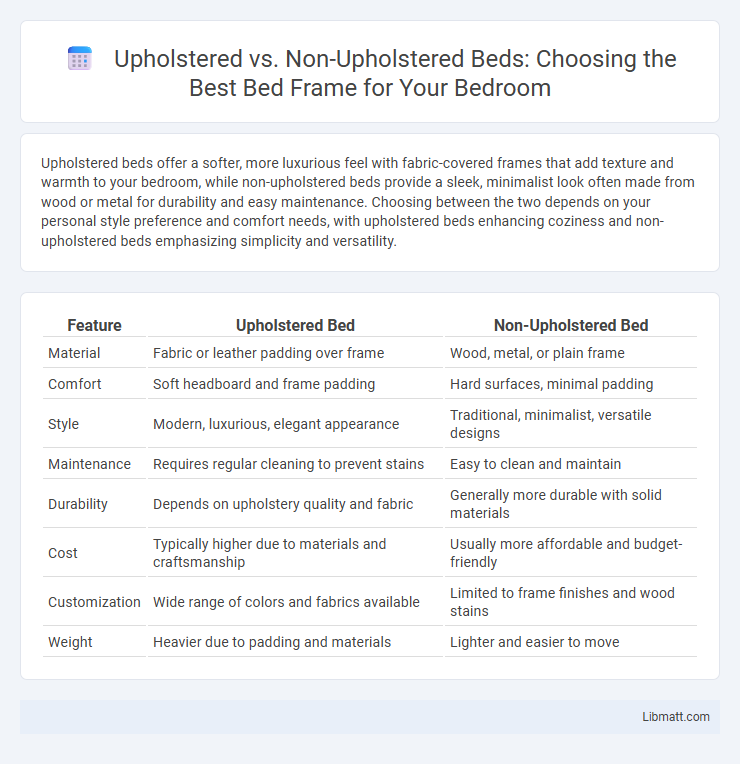Upholstered beds offer a softer, more luxurious feel with fabric-covered frames that add texture and warmth to your bedroom, while non-upholstered beds provide a sleek, minimalist look often made from wood or metal for durability and easy maintenance. Choosing between the two depends on your personal style preference and comfort needs, with upholstered beds enhancing coziness and non-upholstered beds emphasizing simplicity and versatility.
Table of Comparison
| Feature | Upholstered Bed | Non-Upholstered Bed |
|---|---|---|
| Material | Fabric or leather padding over frame | Wood, metal, or plain frame |
| Comfort | Soft headboard and frame padding | Hard surfaces, minimal padding |
| Style | Modern, luxurious, elegant appearance | Traditional, minimalist, versatile designs |
| Maintenance | Requires regular cleaning to prevent stains | Easy to clean and maintain |
| Durability | Depends on upholstery quality and fabric | Generally more durable with solid materials |
| Cost | Typically higher due to materials and craftsmanship | Usually more affordable and budget-friendly |
| Customization | Wide range of colors and fabrics available | Limited to frame finishes and wood stains |
| Weight | Heavier due to padding and materials | Lighter and easier to move |
Introduction to Upholstered and Non-Upholstered Beds
Upholstered beds feature frames covered in fabric, leather, or faux leather, offering a soft, cushioned surface that enhances comfort and adds a touch of elegance to bedroom decor. Non-upholstered beds typically have exposed wood or metal frames, providing a sleek, minimalist aesthetic with easier maintenance and durability. Choosing between these options depends on style preferences, comfort needs, and upkeep considerations.
Aesthetic Differences: Style and Design
Upholstered beds feature fabric-covered frames that add texture, warmth, and a luxurious feel, often available in various colors and patterns to complement modern, classic, or contemporary interior designs. Non-upholstered beds, typically crafted from wood, metal, or leather, offer a more minimalist and timeless aesthetic, emphasizing clean lines and structural details. The choice between upholstered and non-upholstered beds significantly influences a bedroom's visual appeal, balancing softness and comfort against sleekness and simplicity.
Comfort Comparison: Padding and Support
Upholstered beds provide enhanced comfort through thick padding and soft fabric coverings that offer gentle support and cushioning, ideal for leaning or sitting up in bed. Non-upholstered beds, typically made from wood or metal, offer firmer support with less surface padding, resulting in a more structured feel but less plush comfort. Your choice depends on whether you prioritize the cozy softness of padding or the solid support of a non-upholstered frame for optimal sleep quality.
Durability and Longevity
Upholstered beds often feature fabric or leather covers that can wear over time but offer added comfort and style, while non-upholstered beds, made from solid wood or metal, typically provide greater durability and longer lifespan due to their robust construction. Your choice should consider maintenance needs, as upholstered beds may require regular cleaning and care to prevent fabric degradation, whereas non-upholstered beds are easier to maintain and resist wear and tear more effectively. Investing in a high-quality frame is crucial for both types to ensure maximum longevity.
Maintenance and Cleaning Requirements
Upholstered beds demand regular vacuuming and spot cleaning to prevent dust buildup and fabric staining, often requiring specialized cleaning products depending on the material. Non-upholstered beds, typically made of wood or metal, are easier to maintain with simple dusting and occasional polishing or wiping to remove dirt and prevent corrosion. Choosing between the two affects cleaning efforts, with upholstery posing a higher maintenance commitment due to fabric care needs.
Cost and Budget Considerations
Upholstered beds typically have higher upfront costs due to the added materials and craftsmanship involved in covering the frame with fabric or leather, making them a premium choice for budget-conscious shoppers. Non-upholstered beds generally offer more affordable price points with simpler construction, ideal for those prioritizing cost efficiency without sacrificing durability. Evaluating long-term maintenance costs is also crucial, as upholstered beds may require cleaning or repairs to fabric, potentially increasing overall expenses compared to their non-upholstered counterparts.
Material Options and Variations
Upholstered beds offer a variety of fabric options such as linen, velvet, leather, and synthetic blends, providing enhanced comfort and style customization. Non-upholstered beds typically feature materials like wood, metal, and engineered wood, favoring durability and a more minimalist aesthetic. The choice between these materials affects maintenance, texture, and overall bedroom ambiance, catering to different design preferences and lifestyle needs.
Space and Room Compatibility
Upholstered beds often require more space due to their padded frames and headboards, making them ideal for larger rooms where their design elements can be fully appreciated without overwhelming the space. Non-upholstered beds feature minimalistic frames, allowing for better compatibility in smaller rooms and offering greater flexibility in arranging other furniture. Choosing the right bed type depends on room size and desired aesthetic, with upholstered beds adding warmth and texture, while non-upholstered options maximize spatial efficiency.
Health and Allergen Factors
Upholstered beds, with their fabric coverings, can trap dust mites, pet dander, and other allergens, potentially affecting indoor air quality and aggravating allergies or asthma. Non-upholstered beds, often made of wood or metal, are easier to clean and less likely to harbor allergens, promoting a healthier sleeping environment. Considering Your health, choosing a non-upholstered bed may reduce allergen exposure and support better respiratory comfort.
Final Verdict: Which Bed Type is Right for You?
Choosing between an upholstered bed and a non-upholstered bed depends on your style preferences, maintenance willingness, and comfort needs. Upholstered beds offer enhanced comfort with padded headboards and a luxurious aesthetic but may require more upkeep due to fabric sensitivity. Non-upholstered beds provide a sleek, durable option with easier cleaning and generally lower maintenance, making them ideal for minimalist or practical bedroom designs.
Upholstered Bed vs Non-Upholstered Bed Infographic

 libmatt.com
libmatt.com